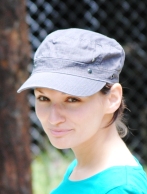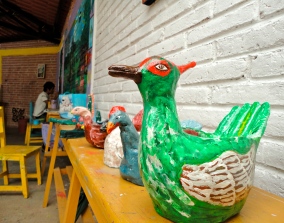Romy Jones, a doctoral student in UMBC’s Language, Literacy & Culture program, is Community Liaison for the Office of Graduate Student Life.
 Community service is a well-known concept, practiced in high schools and universities across the country. But what about reverse community service, an alternative way to partner with communities? A Google search comes up virtually empty, and whenever I tell people about my reverse community service experience I receive stunned looks followed by a moment of silence.
Community service is a well-known concept, practiced in high schools and universities across the country. But what about reverse community service, an alternative way to partner with communities? A Google search comes up virtually empty, and whenever I tell people about my reverse community service experience I receive stunned looks followed by a moment of silence.
I had the same reaction before traveling to the Highlands of Chiapas, Mexico this summer to participate in such service. The idea behind it is a simple one – instead of going to a community to aid in their development, you go to listen and to learn in order to gain new insights and skills that can benefit your own community. This dialogue, in turn, allows the host community to share their ideas, raise awareness of issues affecting their community, and build a solidarity network.
The learning taking place in reverse community service is not studying up; that is, it does not entail traveling to a richer, more developed, or more prestigious community in an effort to learn how to achieve the same level of wealth and development. On the contrary, my reverse community service experience led me to an indigenous community in Chiapas, the poorest region in Mexico. Its indigenous population remains marginalized and experiences great hardship. That begs the question: What can we in the western world learn from an impoverished and marginalized community in a ‘peripheral’ country? As it turns out, a lot.
Their approach to education is a great example. Closely aligned with Paulo Freire’s popular education model, teachers (called promoters of education in the Chiapas community I stayed) and students have a horizontal relationship. That is, both serve as a source of knowledge. In the classes I took in this community, the promoter only provided prompts to start class discussion. The development of this discussion is largely in students’ hands thereafter. Other times it was completely open to us what we wanted to discuss. One important component of these discussions was the link back to our own communities and experiences, which allowed my fellow students and me to take ownership of what we learned and successfully encouraged engagement with the material. We were not simply empty vessels to be filled, but instead co-creators of our own education.
There is much we can learn from this type of education. There are already exciting efforts at UMBC to bridge textbook material with communities in which students have a stake, such as AMST422: Preserving Places, Making Spaces in Baltimore, ART390: Imaging Research Fellows, and HIST495/705: West Side Stories: Public History as a Cornerstone of Urban Revitalization. But what else can we do? How can we create reverse community service here at UMBC? How can all of us at UMBC become ‘promoters of education’? Or are we already?
Contact the author, Romy Jones, at rjones12@umbc.edu.


Great post, Romy! This is a really exciting concept. It seems so intuitive that we would seek to learn from each other, as we all have things to share, but somehow we forget that in formal education. We have a lot to learn Mexico and other, more collective cultures!
Nice thoughts and founds, Romy! 😉 And great pic! You should have uploaded the picture of mural as well! 😀 Great point of view. It is like an alarm clock which wakes us up. People might have been thinking for a long time that our education is good enough. And how to make a progress in our education is kind of a “it topic” in their discussion. Here it is!! This is a good way to make more connections with other cultures as well as be more creative in ours!